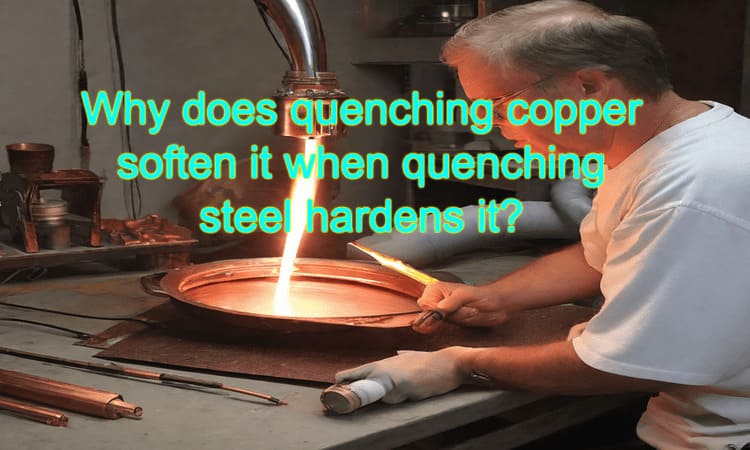Quenching, a rapid cooling process used in metallurgy, has contrasting effects on copper and steel. While quenching hardens steel, it softens copper alloys.
The underlying metallurgical mechanisms driving these divergent outcomes can be attributed to differences in crystal structure, carbon solubility, and the behavior of dislocations.
In this blog post, we will learn the metallurgical aspects of quenching and explore practical examples to illustrate why copper softens while steel hardens.
Crystal Structure and Carbon Solubility
a. Steel
Iron in carbon and low-alloy steels exists in two allotropes: ferrite (α-Fe) and austenite (γ-Fe). Austenite has a face-centered cubic (fcc) crystal structure, with a higher solubility for carbon. When steel is heated above a certain temperature, ferrite transforms into carbon-rich austenite, dissolving carbides such as cementite and alloy carbides.
b. Copper Alloys
Copper has a face-centered cubic (fcc) crystal structure, similar to austenite. However, copper alloys do not exhibit the same high solubility for carbon as austenite in steel.
“Copper alloys undergo work hardening, accumulating dislocations that strengthen the material. However, quenching copper alloys leads to softening because the rapid cooling does not allow for the diffusion necessary to relieve dislocations, thus restoring the material’s ductility.“
Cooling Rate and Transformations:
a. Slow Cooling in Steel
When steel is cooled slowly, reconstructive transformations occur, allowing atoms to diffuse. This results in a microstructure known as pearlite, consisting of ferrite and cementite. Slow cooling provides sufficient time for atomic diffusion and the rearrangement of crystal structures.
b. Rapid Cooling (Quenching) in Steel
Quenching steel involves rapid cooling that prevents atom diffusion. As a result, martensitic transformation occurs, with minimal diffusion of iron and carbon during the transformation. Martensite exhibits high hardness due to the formation of a high density of dislocations, impeding plastic flow.
Dislocation Behavior and Work Hardening
When copper alloys undergo cold deformation, dislocations accumulate, leading to work hardening. The increased dislocation density enhances the flow stress of the material, making it stronger but less ductile.
Copper Softening Mechanism
Exposing work-hardened copper alloys to high temperatures allows atoms to diffuse, relieving the dislocation structure. This diffusion-mediated process softens the material by reducing dislocation density and restoring the material’s ductility.

Practical Examples
- Steel Application: Knife Blade
- Quenching a high-carbon steel knife blade after heating it to austenitizing temperature results in martensitic transformation, imparting high hardness for a sharp and durable edge.
- Copper Alloy Application: Electrical Connectors
- Copper-based electrical connectors are typically work-hardened through cold deformation to enhance their mechanical strength. However, if these connectors are exposed to elevated temperatures during soldering, the heat softens the material, relieving dislocations and facilitating easier shaping and joining.
Conclusion
The differential effects of quenching on copper and steel arise from variations in crystal structure, carbon solubility, and the behavior of dislocations. Steel hardens due to the formation of martensite, characterized by a high density of dislocations impeding plastic flow.
In contrast, copper alloys undergo work hardening, accumulating dislocations that increase strength but reduce ductility. Softening occurs in copper alloys when exposed to elevated temperatures, allowing atomic diffusion and relieving dislocations.
